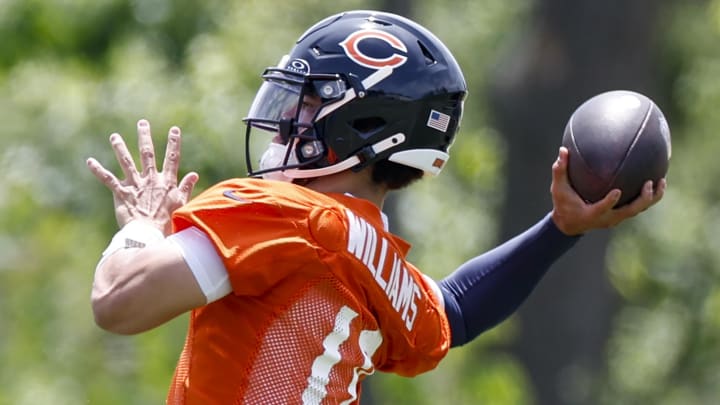Projecting Caleb Williams Rookie Production Numbers

There is much to consider when pondering Caleb Williams' rookie possibilities.
Projecting success for a rookie—whether by the average Bears fan trying to address their own offseason angst or by the fantasy football owner—depends on an equation with so many factors.
When Williams departed for his vacation period after quarterback school and minicamp, coaches felt certain they'd seen desired progress even if something as simple as getting cadences correct seemed a problem.
"The one thing with the development of Caleb in terms of what he's gotten to do this offseason has been outstanding," coach Matt Eberflus said. "You know, taking him from knowing just a little bit about the scheme from that Pro Day at USC all the way to where he is now and it's really good."
Offensive coordinator Shane Waldron addressed "good" more specifically.
"His competitive nature, his willingness to learn, his desire to know the why on everything that is happening so that he's not just out there robotic, trying to just run a play," Waldron said. "He's out there really learning it, really understanding it, knowing there is a long way to go in terms of going from one offense to another but not skipping any of the steps and knowing in order to achieve greatness he has to put in a lot of hard work and he's backed that up with what he's demonstrated so far in the time we have been around him."
Expecting Williams to enjoy a rookie season along the lines of the one C.J. Stroud had last year is probably taking it too far. Yet, there are so many reasons to expect at least that.
Bears fans should be so hyped right now & not just because one play in OTA’s.
— Chase Daniel (@ChaseDaniel) May 22, 2024
Caleb Williams has a chance to become the first QB in #dabears history to throw for 4,000 yds in a season. He’s going to do it. pic.twitter.com/fZckq3OuWy
To many, Dak Prescott had the best rookie season with 23 TD passes and 3,667 yards. It would be difficult to pass his 23 TDs-to-four interception ratio considering he was drafted by a team with possibly the best offensive line in the league at the time.
Stroud's TD pass total was also 23 and he threw only five interceptions, but had 4,108 yards.
The 27 TD passes Baker Mayfield threw would be difficult to top but all factors pulled together, Bears On SI anticipates Williams to throw more TD passes than both of those QBs at 24 based on a full 17-game slate. Anticipate more interceptions than those quarterbacks with nine as Williams is prone to taking chances deep and will do so again, at least initially. He'll not approach the 4,108 yards but 3,690 will leave a strong impression.
Williams will pull in a passer rating of 90.86 as a rookie after completing 64.4% of his passes.
Here are the elements considered while recaching this conclusion:
Latu repeatedly beating his guy/guys than trying to chase down Caleb Williams produced some extremely Looney Tunes moments pic.twitter.com/TLItHo0xwq
— Mina Kimes (@minakimes) February 19, 2024
The Surrounding Cast
Here are the best three passing targets for rookie QBs chosen No. 1 overall since the merger of the AFL and NFL: AJ Green, Tee Higgins and Tyler Boyd for Joe Burrow; Larry Fitzgerald, Christian Kirk and Damiere Byrd for Kyler Murray with the Cardinals; and Reggie Wayne, Ty Hilton and Donnie Avery for Andrew Luck with the Colts.
Green was 32 and coming off a bad ankle injury. Fitzgerald was 36 years old and Reggie Wayne was 34.
BOLDEST PREDICTIONS FOR 2024 CHICAGO BEARS SEASON
WHERE BEARS GM RYAN POLES TOOK HIS BIGGEST GAMBLES
Williams will have three better targets in Rome Odunze, Keenan Allen and DJ Moore plus a 70-catch tight end in Cole Kmet and one with over 50 catches the last two years in Gerald Everett.
The supporting goes beyond his receivers. He has two running backs who have averaged over 4.6 yards per carry in their careers and is backed by a defense which came into its own in the season's second half last year to tie for the interception lead.
"If your a Bears fan, you finally feel like, hey we might have something special here." - @Hasselbeck on what Bears fan should expect with Caleb Williams this upcoming season. pic.twitter.com/G10RpDOw9p
— Dan Patrick Show (@dpshow) June 27, 2024
The Bears were ascending already in the second half with five wins in their last eight, and most QBs chosen first overall since the merger went to teams coming off losing seasons. In fact, the only one who didn't was Jeff George. He went to an 8-8 team. Only three QBs chosen first overall went to seven-win teams like Williams did.
The one aspect of his supporting cast less certain is probably the most critical one. This is the offensive line. How will the Bears offensive line perform without the benefit of a QB who scrambles like Justin Fields did?
Williams is a scrambler, too, but scrambles to throw and not to pick up yards with his legs unless he's out of options. Beyond that, the Bears offensive line last year showed it can perform well as pass blockers if given a chance. With Tyson Bagent at quarterback, the sack rate was 3.4%. It was 10.7% with Fields at QB.
Bears offense = LOADED 🐻⬇️ pic.twitter.com/38OrUPZeUO
— Caleb Williams Fan Club (@CalebFC18) June 29, 2024
Matt Eberflus when Caleb Williams throws his 4th INT of the game.#DaBears🧸#NFL🏈 pic.twitter.com/09zCp7jbrE
— Rip (@Gambling400) June 26, 2024
The Coaches
While it's perceived by many Eberflus is in a must-win year, no one who matters has hinted at this. It would make more sense that unless something catastrophic happens, they would give him the second year with the same QB and staff for the sake of continuity.
Eberflus is a defensive coach, but so is Stroud's head coach, DeMeco Ryans.
Justin Fields broke in with the benefit of an offensive-side head coach in Matt Nagy. The offensive coordinator was Bill Lazor, who had NFL experience at his job like Waldron does. However, Waldron has a far better passing background as a disciple of Sean McVay.
The Bears say they have a plan in place for bringing Williams along and have executed it even in this down period.
"I think a good coach sets it up for his players and we do that," Waldron said. "We set it up for him. We give him the tools to use. And again, it's on their own time and all that, but I think you give him the keys to the car, but you also show him how to drive. And that's what a good coach does."
Lions WR Amon-Ra St. Brown teasing Bears Rookie QB Caleb Williams on his Instagram story 🤣#OnePride pic.twitter.com/T8m6amsobz
— 𝔗𝔥𝔢 𝔇𝔢𝔱𝔯𝔬𝔦𝔱 𝔗𝔦𝔪𝔢𝔰 📰 (@BrandNewDET) June 28, 2024
Williams' Throwing History
A major pitfall for rookie passers is targeting the same top receiver time and again, becoming predictable and not getting through the progression. Williams has never been this way. He is not target-dependent.
Despite three prodigious passing seasons in college, he never had a wide receiver who had more than 59 catches because he dispersed the ball so evenly. At Oklahoma he may have had better receivers overall than at USC and had no one with 40 receptions but had five with at least 32. At USC, Jordan Addison, Tahj Washington, Brenden Rice and Mario Williams all failed to reach 60 catches and only Washington (1,062 yards) got to 1,000 yards.
Williams knew how to throw to backs and understood the importance of balancing out the passing attack.
Williams' Scrambling
He's not going to give the Bears or fantasy owners the big points for rushing that Fields did, but he still will run it. Williams ran for 945 yards and 27 touchdowns in college. The red zone value he has could be greatly enhanced because of his quick feet.
BEARS FIND CALEB WILLIAMS DIFFERENT THAN ORIGINALLY ADVERTISED
However, he actually gained almost 700 more yards because college football counts sack yardage as yards off the rushing total. The threat of his running can help open receivers as he buys time with his feet, and if they never come open, he'll take it himself.
The Bears need him to be going out of bounds or sliding, rather than taking big late hits the way Fields always seemed to do--without drawing a flag.
This ability to add as a runner is a major reason Michael Fabiano of Sports Illustrated can put Williams No. 8 overall among quarterbacks for startup fantasy drafts, ahead of Green Bay's Jordan Love.
#Titans DT Jeffery Simmons when asked about playing Caleb Williams Week 1
— Wes Wisley (@TitansStats) June 26, 2024
“Painted nails” 🤣
(🎥: Rich Eisen Show) pic.twitter.com/Ontm0gQz8B
The Myths
Williams took longer than almost all other college passers to throw over his three years but Trevor Sikkema of Pro Football Focus explained he actually was more a victim of a faulty offensive line last year.
"If you take away the plays in which they fully broke down and he was moved off of his spot, if you take those away, his time to throw within structure is exactly like everybody else's," Sikkema said during an appearance on the NFL Stock Exchange podcast with Connor Rogers.
That time would have been in the range of 2.5-2.6 seconds, Sikkema said.
Williams also has been viewed as a big risk taker downfield by many but PFF's analysis called him the best short passer in the country last year.
The short passing game is where the money is made in the NFL. The catch and run and throws underneath the coverage keep the chains moving in a way like the running game used to in former times.
Putting together all of these factors, Williams appears more than capable of putting up numbers approaching or bettering those of the best first-round rookie QBs.
If Caleb Williams goes for 4000+ yards, 30+ TD’s, and leads the NFL in passer rating, with those weapons, we have to call him a system quarterback
— Jack Parodi (@betr_jack) May 2, 2024
Because that’s EXACTLY what folks did with Brock Purdy when he put up those exact numbers last year pic.twitter.com/JZuAtjWvah
Caleb Williams at a Glance
Vitals: 6-foot-1 1/8, 214 pounds, rookie season.
College Career: 1,099 pass attempts, 735 completions, 10,082 yards, 66.9% completion rate, 9.2 yards/attempt 93 TDs, 14 interceptions, NFL passer rating 118.9, college passer rating 169.3; 289 rushes, 966 yards, 27 TDs, 3.3 yards per attempt (rushing includes minus-646 yards lost on sacks)
2023: 388 passes, 266 completions, 3,633 yards, 68.6% completions, 30 TDs, 5 interceptions, 9.4 yards/attempt 118.6 NFL passer rating, 170.1 college passer rating; 97 rushes, 142 yards (includes sacks and yards lost for sacks).
2024 Bears On SI Projection: 361 completions, 560 attempts, 3,690 yards, 6.6 yards per attempt, 64.4% completions, 24 TDs, 9 INTs, 90.86 rating; 63 rushes, 377 yards, 5.9 yards per attempt, 5 TDs.
Michael Fabiano's SI Fantasy Ranking: No. 8 among all NFL quarterbacks.
What are the realistic expectations for Caleb Williams year 1? 🤔 @BleavNetwork @PatTheDesigner & I go over that in the latest pod. Check it out 📈👇🏽 #Bears #NFL
— Sky Kruse (@KruseSports_) June 29, 2024
Spotify: https://t.co/eSGoVgPD05
Apple: https://t.co/OP5hWBJ4WR pic.twitter.com/Br59SqxaOW
Twitter: BearDigest@BearsOnMaven
READ ALSO:
